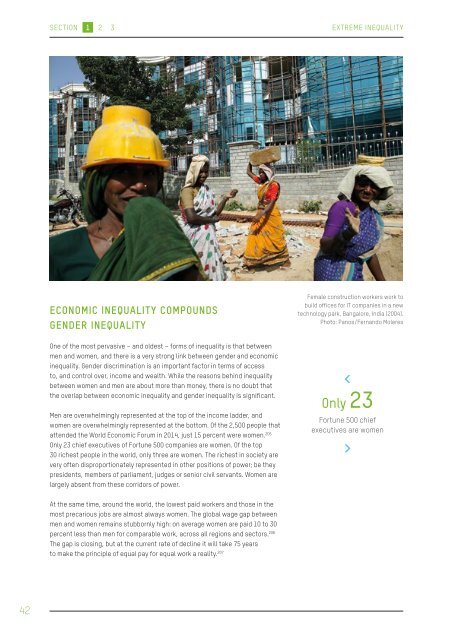1FW2e8F
1FW2e8F
1FW2e8F
You also want an ePaper? Increase the reach of your titles
YUMPU automatically turns print PDFs into web optimized ePapers that Google loves.
SECTION 1 2 3<br />
EXTREME INEQUALITY<br />
ECONOMIC INEQUALITY COMPOUNDS<br />
GENDER INEQUALITY<br />
Female construction workers work to<br />
build offices for IT companies in a new<br />
technology park, Bangalore, India (2004).<br />
Photo: Panos/Fernando Moleres<br />
One of the most pervasive – and oldest – forms of inequality is that between<br />
men and women, and there is a very strong link between gender and economic<br />
inequality. Gender discrimination is an important factor in terms of access<br />
to, and control over, income and wealth. While the reasons behind inequality<br />
between women and men are about more than money, there is no doubt that<br />
the overlap between economic inequality and gender inequality is significant.<br />
Men are overwhelmingly represented at the top of the income ladder, and<br />
women are overwhelmingly represented at the bottom. Of the 2,500 people that<br />
attended the World Economic Forum in 2014, just 15 percent were women. 205<br />
Only 23 chief executives of Fortune 500 companies are women. Of the top<br />
30 richest people in the world, only three are women. The richest in society are<br />
very often disproportionately represented in other positions of power; be they<br />
presidents, members of parliament, judges or senior civil servants. Women are<br />
largely absent from these corridors of power.<br />
<<br />
Only 23<br />
Fortune 500 chief<br />
executives are women<br />
><br />
At the same time, around the world, the lowest paid workers and those in the<br />
most precarious jobs are almost always women. The global wage gap between<br />
men and women remains stubbornly high: on average women are paid 10 to 30<br />
percent less than men for comparable work, across all regions and sectors. 206<br />
The gap is closing, but at the current rate of decline it will take 75 years<br />
to make the principle of equal pay for equal work a reality. 207<br />
42


